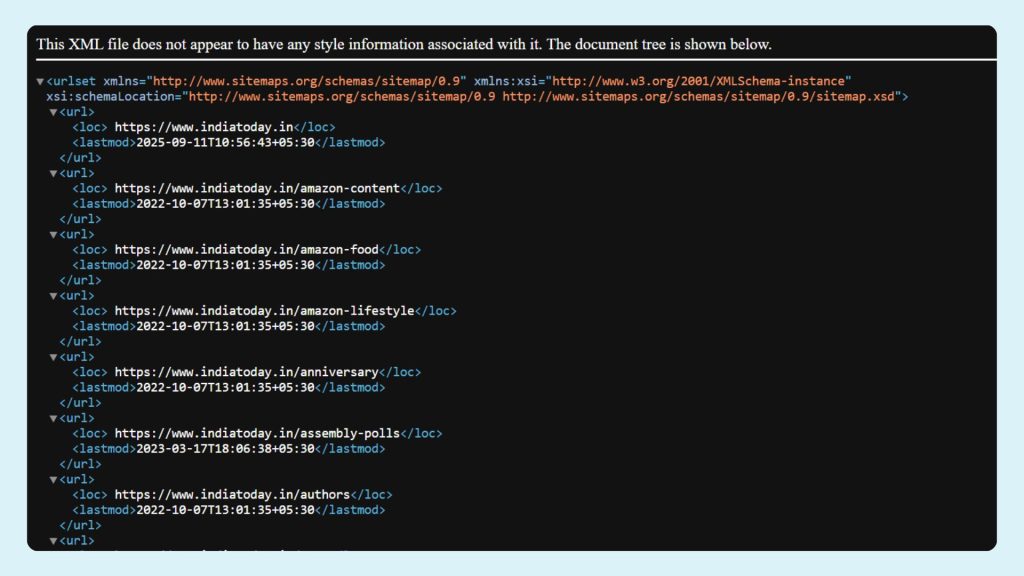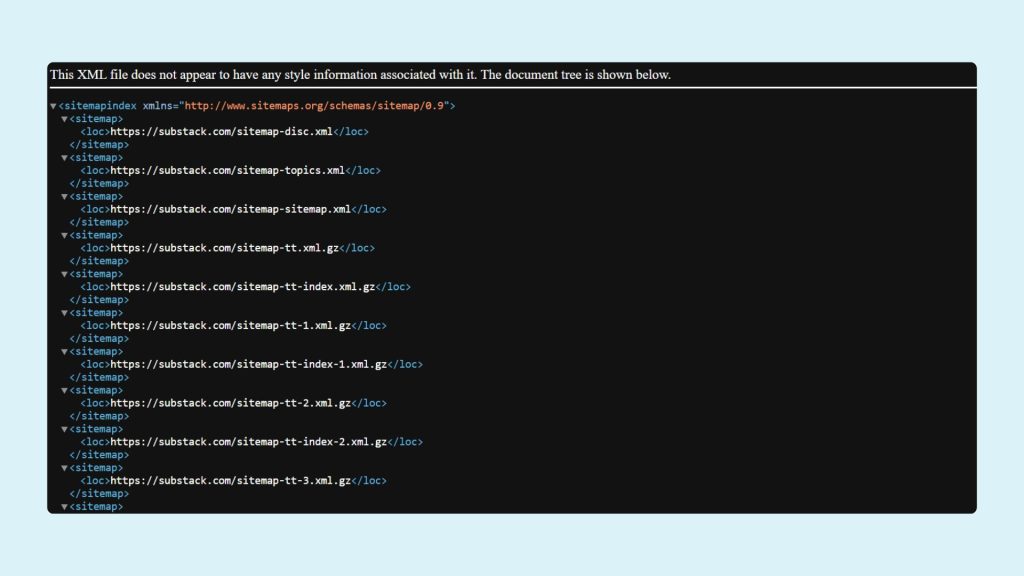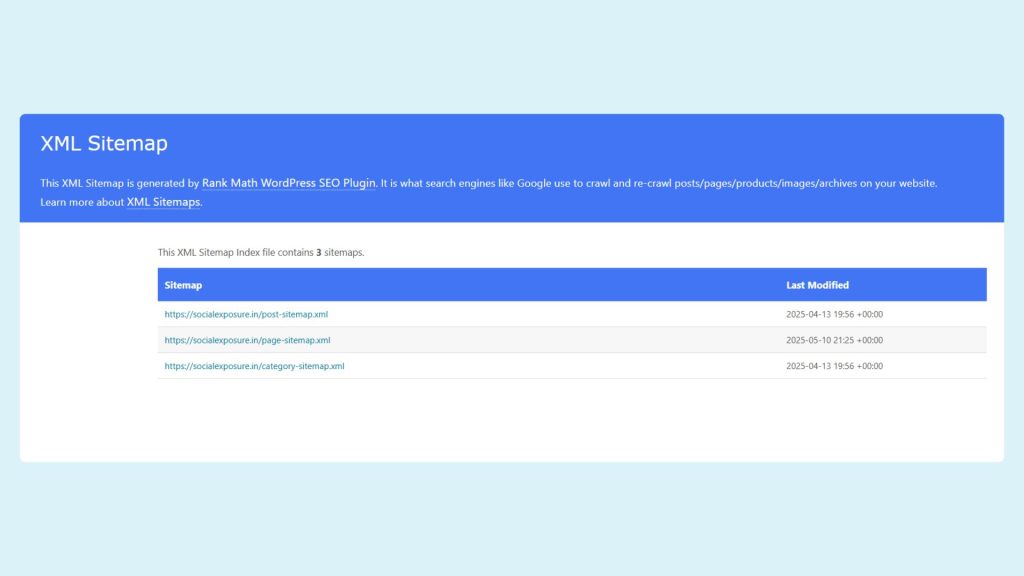When people first come across the word sitemap, they often wonder if it is just another technical detail or something that really affects how a site works. A website sitemap is more than a list of pages; it acts as a guide that helps search engines understand your site’s structure and makes it easier for visitors to find what matters.
Recent developments show that search engines like Google and Bing increasingly rely on structured signals, particularly sitemaps, to crawl and index pages more efficiently. Microsoft’s 2025 research confirms that sitemaps have become critical infrastructure for AI-powered search systems, which have moved away from traditional brute-force crawling to more selective, signal-based approaches.
For larger sites, optimized sitemaps can make the difference between content being crawled efficiently or remaining buried in complex site structures. Even smaller sites benefit when new updates or pages need faster indexing, as sitemaps provide direct signals to search engines about content freshness and priority.
By keeping things simple and focused, this guide will show you exactly what a sitemap does, why it matters, and how it helps your site grow. All explained in clear language, with practical takeaways you can use right away with Social Exposure.
What is a Sitemap?
A sitemap is a file that lists the pages of a website, showing search engines how the site is organized. It helps crawlers discover content and understand how different pages connect.
The purpose of a sitemap is simple:
- Support crawling by giving search engines a clear path to follow.
- Speed up search engine indexing, making new pages easier to find.
- Highlight important pages so they are not missed.
- Provide details like the last updated date in XML sitemap files.
According to Google Search Central, sitemaps are most helpful for large websites or those with frequently changing content, as they guide search engines to new or updated pages more efficiently. From an optimization point of view, sitemap ensures that search engines receive structured signals about a site’s content.
Why Does a Sitemap Matters for Your Website?
A sitemap plays a direct role in how search engines interact with your site. It is not just about listing pages; it’s about improving visibility and making sure the right pages are seen.
Here’s why it matters:
- Faster discovery: New or updated content can appear in search results sooner, as crawlers use the sitemap as a guide.
- Support for complex sites: When a site has many categories, tags, or products, a sitemap helps search engines map the structure without missing pages.
- Improved visibility: By highlighting essential content, sitemaps strengthen indexing speed and boost site visibility.
- SEO benefits: With sitemap, search engines understand the layout of your site, which supports better ranking opportunities.
Businesses with content-heavy websites, e-commerce platforms, and startups aiming for faster growth rely on different types of sitemaps to give their audience and search engines a smoother experience.
Types of Sitemaps
There are different types of sitemaps, each serving a unique purpose. Knowing the difference helps you decide which format fits your site best.
- XML Sitemap: The most common file format used by search engines. It provides a structured list of page URLs along with details like when they were last updated, which makes crawling more efficient. An XML sitemap is particularly valuable for large or frequently updated websites. For more details, check out Google’s best practices for XML Sitemaps and RSS/Atom feeds.
- HTML Sitemap: Visible to users, this works like a directory helping visitors navigate the site’s sections. While it has secondary importance for search engines, it greatly improves user experience.
- Image Sitemap: Ideal for sites with galleries or product catalogs to help search engines find images that might not be linked directly.
- Video Sitemap: Useful for media-heavy platforms; highlights video content for better search features.
- News Sitemap: Designed for publishers that post frequent updates, helping identify time-sensitive articles quickly.
- RSS, mRSS, and Atom 1.0 Sitemap: Syndication feed formats that work alongside XML sitemaps to provide info about recent content changes. Most CMSs automatically generate these, and Google recommends submitting both XML and RSS/Atom feeds for optimal crawling.
- Text Sitemap: A plain text file listing one URL per line, saved in UTF-8 encoding, supporting up to 50,000 URLs per file. Great for sites needing only URL submission without extras. Check out the official Sitemaps Protocol for specs.
- Sitemap Index: For very large sites, multiple sitemaps can be grouped into one index file, streamlining management. Each index can reference up to 500 sitemaps.
Together, these formats make a website sitemap system more comprehensive and efficient. The XML sitemaps provide complete structure information, while RSS/Atom feeds keep search engines updated on new changes.
Each format has size limits (50MB or 50,000 URLs) per file, so larger sites use sitemap indexes to keep signals clean and crawling fast.
Do All Websites Need a Sitemap?
Not every site requires a sitemap, but many benefit from having one. Whether it’s necessary depends on your site size, structure, and content type.
A sitemap is most useful when:
- The site is large, such as an e-commerce platform with thousands of product pages.
- Content updates frequently, like on news websites or blogs with daily posts.
- The structure is complex, with many subcategories or pages not easily linked.
- The site is new and has few external links, making discovery slower.
A sitemap may not be required when:
- The site is small, with only a few pages.
- All pages are well-linked internally, making them easy for crawlers to find.
- Updates are rare, and content changes minimal.
Adding a sitemap is rarely disadvantageous. Even small sites can see indexing benefits. So while not always essential, a sitemap provides a safety net helping search engines find and index your content reliably.
Advanced Considerations
- Changefreq & Priority Tags: <changefreq> and <priority> are treated as hints and often ignored by Google in favor of its own crawling heuristics.
- Hreflang & Multiregional Sites: Include hreflang tags in sitemaps or use separate locale sitemaps to help search engines serve correct regional content.
- Monitoring & Error Handling: Submit your sitemap to Google Search Console and Bing Webmaster Tools; use reports to fix errors before indexing issues arise.
- Content Behind Authentication: Sitemaps can’t reveal password-protected or form-gated URLs. Provide accessible crawl paths or indexable landing pages instead.
- RSS/Atom & API Alternatives: Very dynamic sites may supplement or replace XML sitemaps using RSS/Atom feeds or Google’s Indexing API for instant URL submission.
How to Find a Sitemap of a website?
Locating a sitemap is simple if you know where to look. Here are the common ways to find a website’s sitemap file:
- Check common URLs: Try https://example.com/sitemap.xml or https://example.com/sitemap_index.xml.
- Check robots.txt: View https://example.com/robots.txt for a Sitemap: entry listing the sitemap location.
- View source code: Inspect page source, especially <head> or footer, for a <link rel=”sitemap”> or sitemap URL.
- Webmaster tools: Verified properties in Google Search Console and Bing Webmaster Tools show submitted sitemaps.
- SEO crawlers: Tools like Screaming Frog or Sitebulb can detect sitemap URLs automatically.
- Online sitemap checkers: Use free tools to scan a site and report available sitemaps.
These methods confirm if a sitemap exists and help verify proper setup.
How to Create a Sitemap?
You can build a sitemap depending on platform and control needs:
CMS Plugins:
- WordPress plugins like Yoast SEO, Rank Math, All in One SEO auto-generate sitemaps.
- Shopify includes built-in sitemap generation at /sitemap.xml.
- Joomla’s OSMap extension creates XML and HTML sitemaps.
Online Generators:
- Tools like XML-Sitemaps.com generate sitemaps for up to 500 URLs free, ideal for small or test sites.
Manual/Developer:
- Write XML following Google’s Sitemap guidelines.
- Use libraries/tools like gulp-sitemap.
- Server-side frameworks generate dynamic sitemaps based on database content.
Choose based on site size and update frequency; automation suits most, manual for full control.
How to Submit a Sitemap to Google and Bing?
Submitting a sitemap helps search engines recognize your content quickly. Both Google and Bing provide tools for this process, and Bing also supports IndexNow for faster updates.
1. Submit Sitemap to Google
- Sign in to Google Search Console.
- Choose your website property.
- Go to the Sitemaps section.
- Enter the URL of your XML sitemap file (for example: https://example.com/sitemap.xml).
- Click submit and check for any errors in the report.
2. Submit Sitemap to Bing
- Sign in to Bing Webmaster Tools.
- Select your site property.
- Open the Sitemaps section.
- Add the sitemap URL and submit it for crawling.
3. IndexNow for Bing
Bing also supports IndexNow, a protocol that notifies search engines about content changes instantly. By enabling IndexNow, updates are picked up faster, which reduces delays in indexing.
Sitemap submission is usually a one-time step, but it is good practice to revisit it if you make significant structural changes or notice errors in reports. Regular checks in Google Search Console and Bing Webmaster Tools keep your XML sitemap working as intended and support consistent indexing. With Social Exposure, known as the Best SEO Agency, sitemap submission becomes a simple but powerful step toward stronger search visibility.
Real World Examples of Sitemaps
Different industries apply sitemaps in ways that fit their site size and structure. These real sitemap examples show how the format adapts.

E-commerce Websites
Large platforms often split files into product, category, and image sitemaps, all connected through a sitemap index. This keeps thousands of URLs organized and easier for crawlers to process.

News and Media Websites
Publishers update constantly, so they use lastmod tags in their XML sitemap example to highlight freshness. This helps search engines recognize breaking stories faster.

Blogs and Personal Sites
Most CMS platforms like WordPress automatically generate a CMS sitemap. This gives bloggers a ready-to-use website sitemap sample without technical effort.

Business Websites
With fewer pages, small company sites often have lightweight sitemaps. Sometimes optional, they still help crawlers identify important sections like services or contact pages.
Your sitemap structure should match the purpose and scale of your site. Large catalogs rely on multiple files, publishers use freshness signals, while smaller sites often need only a simple setup. Social Exposure helps businesses choose the right format by sharing real sitemap examples that suit their goals.
Common Sitemap Mistakes to Avoid
Even though a sitemap is simple in structure, errors in setup can reduce its value. Paying attention to the details prevents problems with crawling and indexing. From an SEO perspective, these issues not only slow down indexing but can also affect how search engines treat your site structure. Avoiding these mistakes keeps your sitemap effective and ensures crawlers get accurate signals.
- Exceeding size/URL limits (50 MB uncompressed, 50,000 URLs)
- Duplicate URLs causing wasted crawl budget
- Broken or redirected links create crawl errors
- Incorrect UTF-8 encoding causes parser failure
- Mixing HTTP/HTTPS or www/non-www URLs dilutes signals
- Invalid XML syntax breaks sitemap processing
- Including unnecessary URL parameters creates duplicates
- Missing sitemap index for large sites leads to ignored URLs
- Listing URLs blocked by robots.txt or meta tags causes crawl conflicts
- Incorrect sitemap file path or restricted access
- Relying heavily on <priority> and <changefreq> tags, which are mostly ignored by modern search engines
By avoiding these technical and strategic pitfalls, you’ll maintain an accurate, reliable sitemap that helps search engines crawl and index your content efficiently.
Quick Facts and Data You Should Know
- XML sitemaps have file size max of 50 MB and URL limit of 50,000 per file.
- Sitemap indexes can group up to 500 sitemap files for large sites.
- Use accurate lastmod tags reflecting meaningful updates.
- Sitemaps must be UTF-8 encoded and comply with the official protocol.
- Many large sites split sitemaps to 10,000–25,000 URLs for manageability.
- Add sitemap location to robots.txt and submit URLs in Google Search Console and Bing Webmaster Tools for monitoring.
A well-structured sitemap does more than list URLs. It helps search engines crawl and index your site reliably. By keeping to these facts, you avoid errors, stay within technical limits, and make your sitemap useful for both small blogs and large e-commerce sites. Regular creation and updates keep your site visible and current in search results.
Conclusion
A sitemap gives search engines a clear map of your content, making it easier for them to crawl and index what matters most. Whether you run a small site or a growing e-commerce store, maintaining an accurate sitemap helps improve visibility and keeps your pages discoverable.
As a practical step, review your sitemap regularly and update it whenever you add new sections or remove outdated pages. It is a simple action that strengthens site performance in the long run.
For expert support, Social Exposure stands out as the Best SEO Agency because we focus on practical strategies that make a real difference. From creating accurate sitemaps to improving how search engines view your site, we help businesses stay visible, attract the right audience, and grow with confidence.
Frequently Asked Questions
How do I check if my website already has a sitemap?
Type https://yourdomain.com/sitemap.xml in your browser. If it loads, your site has a sitemap. Online sitemap checker tools can verify it as well.
Can I have multiple sitemaps for one site?
Yes. Large sites often split URLs into multiple sitemap files and use a sitemap index to manage them.
Do sitemaps help new websites get indexed faster?
Yes. Submitting a sitemap gives search engines direct access to your content, speeding up indexing.
Is there a difference between sitemap.xml and robots.txt?
Yes. Sitemaps list the pages you want crawled, while robots.txt specifies which pages to block.
How often should I update my sitemap?
Update whenever you add, remove, or significantly change pages. Frequent updates are recommended for dynamic sites.
Do sitemaps affect site rankings?
No, but they improve crawling and indexing efficiency, which supports better overall SEO.
Where should I place the sitemap file on my website?
Place it in the root directory (e.g., https://yourdomain.com/sitemap.xml) for easy discovery.
Can I submit a sitemap without Google Search Console?
Yes, you can submit it through Bing Webmaster Tools or reference the sitemap in your robots.txt file.
Are there tools to validate my sitemap?
Yes, Google Search Console provides validation, and third-party sitemap validators are available online.
Should I create separate sitemaps for different languages?
Yes, multilingual sitemaps help search engines serve language-specific URLs correctly.






